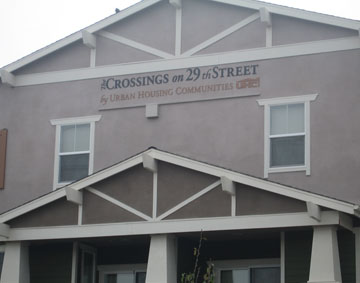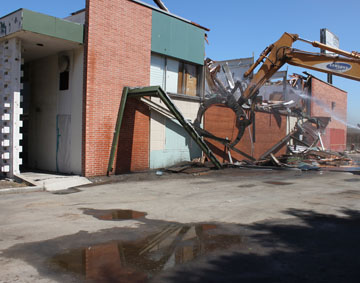 Unless alternative funding can be found, the next phase of the Crossings at 29th street, an affordable housing project in district 9 will come to a halt. Unless alternative funding can be found, the next phase of the Crossings at 29th street, an affordable housing project in district 9 will come to a halt. |
Today is the California Redevelopment Agency’s last official day and the future of dozens of projects in South Los Angeles are at risk of becoming casualties of politics, money and allegations of corruption.
More than 50 housing, public infrastructure, commercial, community service and program development projects in South LA will be on the chopping block, unless other funding can be found to move them forward – 34 are in Councilwoman Jan Perry’s 9th District. Another 17 are in Bernard Parks’ 8th District.
“The pending closure of the agency means that many potential projects, such as the rehabilitation of the Angelus Funeral Home, a historic Paul Williams structure, will be hard pressed to find new funding and it will be incredibly difficult to fill these gaps and get these projects done,” Perry said in a statement.
Also in danger, construction of affordable housing projects such as the extension of the Crossings at 29th Street, which just last week celebrated the grand opening of its first phase.
In CD 8, the controversial Marlton Square project in the Crenshaw district and the Vision Theater in Leimert Park could come to a screeching halt.
The L.A. CRA owns the Marlton Square property, which has been in redevelopment limbo for 20 years. “There were some missteps with the previous developer,” admits Los Angeles CRA spokesman David Bloom. “It’s impossible to say what will happen now, but presumably, it will be sold off. The reality is that some of the properties we own will be more attractive to buyers.”
Technically, more than 400 redevelopment agencies across the state will no longer exist after February 1st, but the winding down of the CRA’s operations and of many projects currently underway need to be taken care of.
 Marlton Square, in district 8, was in redevelopment limbo for 20 years. Demolition finally started in 2011, but now its future is uncertain. Marlton Square, in district 8, was in redevelopment limbo for 20 years. Demolition finally started in 2011, but now its future is uncertain. |
“The government must now appoint three people who live in LA County to be part of a board to run a designated local authority to take over the job of the agency to wind down,” explains Bloom. Until successor agencies are designated to pick up where the redevelopment agency left off, employees will continue going to work during the transition period.
The mission of redevelopment agencies was to improve areas and neighborhoods officially designated as blighted by targeting them for economic development. These areas would benefit from infrastructure improvements, construction of affordable housing projects, business assistance and other programs.
But critics argue that millions of dollars were being invested in areas that were not blighted and hardly any money was spent in areas that were in dire need of economic development.
“The CRA was the biggest cesspool in the world. It never delivered what it was supposed to do – reinvest in underdeveloped communities,” complains author and political science professor Dr. Anthony Asadullah Samad. “Hollywood Boulevard got redeveloped. It got millions of dollars. And communities that should’ve been prioritized didn’t. Almost all of South LA should have gotten money, but didn’t.”
Bloom quickly defended that investment: “People who don’t think Hollywood was blighted have no idea what it looked like. Downtown was not what it’s like now and that’s because of what the CRA did. The agency helped transform areas that were blighted – it was work over many decades so they no longer look blighted.”
Based on a 2011 list of Los Angeles redevelopment projects, the CRA set aside only about $32 million for all of South LA. By comparison, the agency earmarked $52 million for the downtown parking garage that would be adjacent to Eli Broad’s Broad’s proposed museum in the L.A. Civic Center.
Councilwoman Perry, whose district stands a lot to lose by the CRA’s demise, also justified the redevelopment agency’s existence. “I can personally attest to the efficacy of the CRA and the amazing work that we were able to accomplish in partnership. From developing housing for the formerly homeless, to building new grocery stores in areas where there historically had been none to restoring communities by building quality affordable housing, the CRA has helped us reinvigorate and rehabilitate neighborhoods.”
While dozens of projects in South LA will no longer have agency funding, it doesn’t mean they’ll never be built. It will just be harder to get them off the ground, as it will require finding other pools of money. With mounting state and municipal budget deficits, raising funds for even the most well-meaning projects will be a challenge. The bigger question will be who would spearhead efforts to find a way to help and how long it will take to fund the projects that seek to transform South LA from an impoverished area to a prosperous community.
Editor’s note: State law determines that funding for redevelopment projects comes from tax revenues raised in the area where the project is located. When redevelopment agencies improve “blighted” areas, property values in those areas rise, increasing property tax revenues. That increase, a result of redevelopment activity, is referred to as a “tax increment.” The money raised with the tax increment, along with the sale of bonds, finance projects in the area where the taxes were generated.
After the story was published, CRA LA spokesman David Bloom contacted us to say it was unfair to suggest the agency was to blame for the disparity in the different redevelopment project areas. He writes: “Under the provisions of the redevelopment law, funds from a given project area could ONLY be spent in THAT project area. If an area generated fewer resources, we had fewer to spend… The agency invested considerable dollars across many years in South LA. And the proof of the agency’s efforts lies in the great distress that officeholders and community groups are showing at the agency’s dissolution.”
A full list of L.A. projects that will be negatively impacted by the closure of CRA:
Negatively_Impacted_Projects-Page_1.jpg
Negatively_Impacted_Projects-Page_2.jpg
Negatively_Impacted_Projects-Page_3.jpg
Negatively_Impacted_Projects-Page_4.jpg
Projects that will move forward because they’re considered to have “enforceable obligations:”
CRA_EO_Memo-Page_1.jpg
CRA_EO_Memo-Page_2.jpg
CRA_EO_Memo-Page_3.jpg
CRA_EO_Memo-Page_4.jpg
CRA_EO_Memo-Page_5.jpg















Speak Your Mind